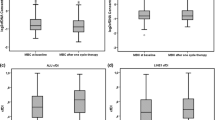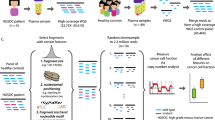Abstract
Circulating or cell-free DNA (cfDNA) has been evaluated as a biomarker in many cancers including breast cancer. In particular, integrity of cfDNA has been shown to be altered in cancers. We have estimated the biomarker potential of cfDNA in primary (PBC) and metastatic breast cancer (MBC). cfDNA integrity (cfDI) and concentration were determined in plasma of 383 individuals, including 82 PBC and 201 MBC cases, as well as 100 healthy controls, by measuring ALU and LINE1 repetitive DNA elements using quantitative PCR. The MBC patient group was further sub-divided into patients with detectable circulating tumour cells (CTCpos-MBC, n = 100) and those without (CTCneg-MBC, n = 101). A hierarchical decrease in cfDI and increase in cfDNA concentration from healthy controls to PBC and further onto MBC patients were observed. Investigation of cfDNA in media of cell lines was in concordance with these results. Combination of cfDI and cfDNA concentration could differentiate PBC cases from controls (area under the curve, AUC = 0.75), MBC cases from controls (AUC = 0.81 for CTCneg-MBC, AUC = 0.93 for CTCpos-MBC), and CTCneg-MBC from CTCpos-MBC cases (AUC = 0.83). cfDI additionally demonstrated a positive correlation to progression-free (HR of 0.46 for ALU, P = 0.0025) and overall survival (HR of 0.15 for ALU and 0.20 for LINE1, P < 0.0001) in MBC, and had lower prediction error than CTC status. Our findings show that reduced cfDI and increased cfDNA concentration can serve as diagnostic markers for PBC and MBC, and cfDI as a prognostic marker for MBC, thereby making them attractive candidates for blood-based multi-marker assays.





Similar content being viewed by others
Abbreviations
- AUC:
-
Area under the curve
- cfDNA:
-
Circulating or cell-free DNA
- cfDI:
-
Cell-free DNA integrity
- CTC:
-
Circulating tumour cells
- CTCpos-MBC:
-
Circulating tumour cells positive metastatic breast cancer
- CTCneg-MBC:
-
Circulating tumour cells negative metastatic breast cancer
- HR:
-
Hazard ratio
- MBC:
-
Metastatic breast cancer
- PBC:
-
Primary breast cancer
- PFS:
-
Progression-free survival
- OS:
-
Overall survival
References
Jemal A, Bray F, Center MM, Ferlay J, Ward E, Forman D (2011) Global cancer statistics. CA Cancer J Clin 61:69–90
Weigelt B, Peterse JL, van ’t Veer LJ (2005) Breast cancer metastasis: markers and models. Nat Rev Cancer 5:591–602
Cardoso F, Castiglione M, Group EGW (2009) Locally recurrent or metastatic breast cancer: ESMO clinical recommendations for diagnosis, treatment and follow-up. Ann Oncol 20(Suppl 4):15–18
Hanash SM, Baik CS, Kallioniemi O (2011) Emerging molecular biomarkers-blood-based strategies to detect and monitor cancer. Nat Rev Clin Oncol 8:142–150
Lumachi F, Brandes AA, Ermani M, Bruno G, Boccagni P (2000) Sensitivity of serum tumor markers CEA and CA 15–3 in breast cancer recurrences and correlation with different prognostic factors. Anticancer Res 20:4751–4755
Pantel K, Alix-Panabiéres C (2010) Circulating tumour cells in cancer patients: challenges and perspectives. Trends Mol Med 16:398–406
Ring AE, Zabaglo L, Ormerod MG, Smith IE, Dowsett M (2005) Detection of circulating epithelial cells in the blood of patients with breast cancer: comparison of three techniques. Br J Cancer 92:906–912
Königsberg R, Obermayr E, Bises G, Pfeiler G, Gneist M, Wrba F et al (2011) Detection of EpCAM positive and negative circulating tumor cells in metastatic breast cancer patients. Acta Oncol 50:700–710
Madhavan D, Zucknick M, Wallwiener M, Cuk K, Modugno C, Scharpff M et al (2012) Circulating miRNAs as surrogate markers for circulating tumor cells and prognostic markers in metastatic breast cancer. Clin Cancer Res 18:5972–5982
Cuk K, Zucknick M, Heil J, Madhavan D, Schott S, Turchinovich A et al (2013) Circulating microRNAs in plasma as early detection markers for breast cancer. Int J Cancer 132:1602–1612
Cuk K, Zucknick M, Madhavan D, Schott S, Golatta M, Heil J et al (2013) Plasma MicroRNA panel for minimally invasive detection of breast cancer. PLoS One 8(10):e76729
Umetani N, Giuliano AE, Hiramatsu SH, Amersi F, Nakagawa T, Martino S et al (2006) Prediction of breast tumor progression by integrity of free circulating DNA in serum. J Clin Oncol 24:4270–4276
Steinman CR (1975) Free DNA in serum and plasma from normal adults. J Clin Investig 56:512–515
De Mattos-Arruda L, Cortes J, Santarpia L, Vivancos A, Tabernero J, Reis-Filho JS et al (2013) Circulating tumour cells and cell-free DNA as tools for managing breast cancer. Nat Rev Clin Oncol 10:377–389
Anker P, Lefort F, Vasioukhin V, Lyautey J, Lederrey C, Chen XQ et al (1997) K-ras mutations are found in DNA extracted from the plasma of patients with colorectal cancer. Gastroenterology 112:1114–1120
Sanchez-Cespedes M, Monzo M, Rosell R, Pifarre A, Calvo R, Lopez-Cabrerizo MP et al (1998) Detection of chromosome 3p alterations in serum DNA of non-small-cell lung cancer patients. Ann Oncol 9:113–116
Balgkouranidou I, Karayiannakis A, Matthaios D, Bolanaki H, Tripsianis G, Tentes AA et al (2013) Assessment of SOX17 DNA methylation in cell free DNA from patients with operable gastric cancer. Association with prognostic variables and survival. Clin Chem Lab Med 51:1505–1510
Wang BG, Huang HY, Chen YC, Bristow RE, Kassauei K, Cheng CC et al (2003) Increased plasma DNA integrity in cancer patients. Cancer Res 63:3966–3968
Jiang WW, Zahurak M, Goldenberg D, Milman Y, Park HL, Westra WH et al (2006) Increased plasma DNA integrity index in head and neck cancer patients. Int J Cancer 119:2673–2676
Umetani N, Kim J, Hiramatsu S, Reber HA, Hines OJ, Bilchik AJ et al (2006) Increased integrity of free circulating DNA in sera of patients with colorectal or periampullary cancer: direct quantitative PCR for ALU repeats. Clin Chem 52:1062–1069
Hauser S, Zahalka T, Ellinger J, Fechner G, Heukamp LC, Vonr A et al (2010) Cell-free circulating DNA: diagnostic value in patients with renal cell cancer. Anticancer Res 30:2785–2789
Deligezer U, Eralp Y, Akisik EE, Akisik EZ, Saip P, Topuz E et al (2008) Size distribution of circulating cell-free DNA in sera of breast cancer patients in the course of adjuvant chemotherapy. Clin Chem Lab Med 46:311–317
Jahr S, Hentze H, Englisch S, Hardt D, Fackelmayer FO, Hesch RD et al (2001) DNA fragments in the blood plasma of cancer patients: quantitations and evidence for their origin from apoptotic and necrotic cells. Cancer Res 61:1659–1665
Giacona MB, Ruben GC, Iczkowski KA, Roos TB, Porter DM, Sorenson GD (1998) Cell-free DNA in human blood plasma: length measurements in patients with pancreatic cancer and healthy controls. Pancreas 17:89–97
Wu TL, Zhang D, Chia JH, Tsao K, Sun CF, Wu JT (2002) Cell-free DNA: measurement in various carcinomas and establishment of normal reference range. Clin Chim Acta 321:77–87
Mouliere F, Robert B, Arnau Peyrotte E, Del Rio M, Ychou M, Molina F et al (2011) High fragmentation characterizes tumour-derived circulating DNA. PLoS One 6(9):e23418
Untergasser A, Nijveen H, Rao X, Bisseling T, Geurts R, Leunissen JAM (2007) Primer3Plus, an enhanced web interface to Primer3. Nucleic Acids Res 35:W71–W74
Jurka J, Kapitonov VV, Pavlicek A, Klonowski P, Kohany O, Walichiewicz J (2005) Repbase Update, a database of eukaryotic repetitive elements. Cytogenet Genome Res 110:462–467
Price AL, Eskin E, Pevzner PA (2004) Whole-genome analysis of Alu repeat elements reveals complex evolutionary history. Genome Res 14:2245–2252
Diehl F, Schmidt K, Choti M, Romans K, Goodman S (2008) Circulating mutant DNA to assess tumor dynamics. Nat Med 14:985–990
Markham NR, Zuker M (2005) DINAMelt web server for nucleic acid melting prediction. Nucleic Acids Res 33(Web Server issue):W577–W581
Team RDC (2010) R: a language and environment for statistical computing. R foundation for statistical computing, Vienna, Austria. ISBN 3-900051-07-0. http://www.R-project.org.
Gerds TA, Schumacher M (2007) Efron-type measures of prediction error for survival analysis. Biometrics 63:1283–1287
Umetani N, Hirmatsu S, Hoon DSB (2006) Higher amount of free circulating DNA in serum than in plasma is not mainly caused by contaminated extraneous DNA during separation. Ann N Y Acad Sci 1075(1):299–307
Wang K, Yuan Y, Cho JH, McClarty S, Baxter D, Galas DJ (2012) Comparing the MicroRNA spectrum between serum and plasma. PLoS One 7(7):e41561
Cao G, Pei W, Lan J, Stetler RA, Luo Y, Nagayama T et al (2001) Caspase-activated DNase/DNA fragmentation factor 40 mediates apoptotic DNA fragmentation in transient cerebral ischemia and in neuronal cultures. J Neurosci 21(13):4678–4690
Huang Q, Li F, Liu X, Li W, Shi W, Liu FF et al (2011) Caspase 3-mediated stimulation of tumor cell repopulation during cancer radiotherapy. Nat Med 17(7):860–866
Liu S, Edgerton SM, Moore D 2nd, Thor AD (2001) Measures of cell turnover (proliferation and apoptosis) and their association with survival in breast cancer. Clin Cancer Res 7(6):1716–1723
Srinivas P, Abraham E, Ahamed I, Madhavan M, Vijayalakshmi NR, Nair MK et al (2002) Apoptotic index: use in predicting recurrence in breast cancer patients. J Exp Clin Cancer Res 21(2):233–238
Holdenrieder S, Burges A, Reich O, Spelsberg FW, Stieber P (2008) DNA integrity in plasma and serum of patients with malignant and benign diseases. Ann N Y Acad Sci 1137:162–170
Ellinger J, Muller SC, Wernert N, von Ruecker A, Bastian PJ (2008) Mitochondrial DNA in serum of patients with prostate cancer: a predictor of biochemical recurrence after prostatectomy. BJU Int 102:628–632
Hauser S, Kogej M, Fechner G, Von Ruecker A, Bastian PJ, Von Pezold J et al (2012) Cell-free serum DNA in patients with bladder cancer: results of a prospective multicenter study. Anticancer Res 32:3119–3124
El Messaoudi S, Rolet F, Mouliere F, Thierry AR (2013) Circulating cell free DNA: preanalytical considerations. Clin Chim Acta 424:222–230
Acknowledgments
We thank the study participants and all our colleagues who helped us with patient recruitment, blood collection and processing. This study was funded and supported by the Dietmar-Hopp Foundation, the University Hospital of Heidelberg, the Helmholtz Society, and the German Cancer Research Center (DKFZ), Heidelberg, Germany.
Author information
Authors and Affiliations
Corresponding author
Additional information
H. Surowy and B. Burwinkel have contributed equally to this work.
Electronic supplementary material
Rights and permissions
About this article
Cite this article
Madhavan, D., Wallwiener, M., Bents, K. et al. Plasma DNA integrity as a biomarker for primary and metastatic breast cancer and potential marker for early diagnosis. Breast Cancer Res Treat 146, 163–174 (2014). https://doi.org/10.1007/s10549-014-2946-2
Received:
Accepted:
Published:
Issue Date:
DOI: https://doi.org/10.1007/s10549-014-2946-2




